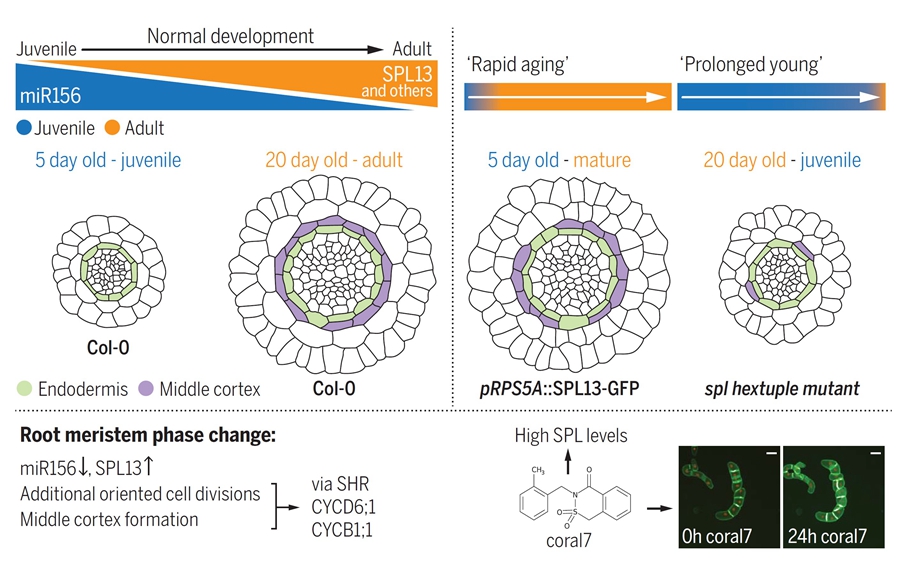The key to three-dimensional plant architecture lies in precise control over the orientation of cell division. Plant cells divide periclinally to grow radially—leading to thickening—while anticlinal division promotes longitudinal growth. This interplay between division orientations forms the diverse plant structures seen in nature.
In a breakthrough study published in Science on Nov. 15, international researchers have identified mechanisms driving age-dependent morphological changes occurring in the root apical meristem during phase change.
“Decoding the mechanisms governing cell division orientation holds great promise for reshaping plant structure at the cellular level,” said Professor YANG Baojun of the Institute of Genetics and Developmental Biology (IGDB), Chinese Academy of Sciences, lead researcher of the study.
This research, entitled “SPL13 controls a root apical meristem phase change by triggering oriented cell divisions (DOI: 10.1126/science.ado4298),” reveals molecular pathways that can significantly enhance crop resilience by reshaping root morphology and thickness.
In collaboration with Dr. Bert De Rybel’s team at Ghent University, YANG and his colleagues created a cell-based screening system to identify small molecules that influence the orientation of plant cell division, testing over 15,000 compounds.
They discovered a compound named “coral7” that affects the transcription factor SPL13 (SQUAMOSA PROMOTER BINDING PROTEIN-LIKE), a critical regulator of root meristem development. SPL13 can influence root meristem thickness by modulating cell division orientation, presenting a promising strategy for root structure redesign, the study found.
Further analysis of SPL13’s function in the root meristem showed notable morphological changes over time, including middle cortex formation and significant thickening of the meristematic zone.
Unlike the wild type, spl mutants displayed defects in middle cortex formation and meristem thickening, underscoring SPL’s critical role in cell division orientation. Studies in monocots, such as rice, confirmed SPL’s conserved function in controlling cell division orientation and root thickening, marking it as a key gene for root thickness optimization.
This research highlights how spatiotemporal morphological changes in roots are regulated by the SPL module, providing a genetic basis for root system improvements, such as thickening and resilience enhancement.
These findings may drive future innovations in crop breeding for water and nutrient-efficient crops, an urgent need in global agriculture, according to YANG.
The research was supported by the National Natural Science Foundation of China, the European Research Council, the Research Foundation-Flanders, and the China Scholarship Council.
Spatiotemporal changes in root morphology and strategies for root thickening (Image by IGDB)
Contact:
Dr. YANG Baojun
Institute of Genetics and Developmental Biology, Chinese Academy of Sciences
Email: bjyang@genetics.ac.cn
 Spatiotemporal changes in root morphology and strategies for root thickening (Image by IGDB)Contact:Dr. YANG BaojunInstitute of Genetics and Developmental Biology, Chinese Academy of SciencesEmail: bjyang@genetics.ac.cn
Spatiotemporal changes in root morphology and strategies for root thickening (Image by IGDB)Contact:Dr. YANG BaojunInstitute of Genetics and Developmental Biology, Chinese Academy of SciencesEmail: bjyang@genetics.ac.cn CAS
CAS
 中文
中文




.png)
